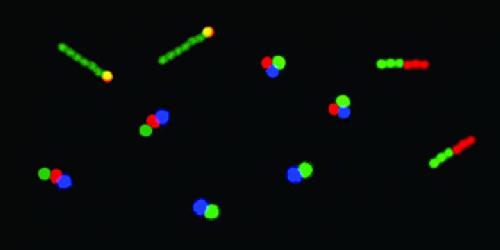Scientists at ETH Zurich and IBM Research Zurich have developed a new technique that enables for the first time the manufacture of complexly structured tiny objects joining together microspheres. The objects have a size of just a few micrometres and are produced in a modular fashion, making it possible to program their design in such a way that each component exhibits different physical properties. After fabrication, it is also very simple to bring the micro-objects into solution. This makes the new technique substantially different from micro 3D printing technology. With most of today's micro 3D printing technologies, objects can only be manufactured if they consist of a single material, have a uniform structure and are attached to a surface during production.
To prepare the micro-objects, the ETH and IBM researchers use tiny spheres made from a polymer or silica as their building blocks, each with a diameter of approximately one micrometre and different physical properties. The scientists are able to control the particles and arrange them in the geometry and sequence they like.
The structures that are formed occupy an interesting niche in the size scale: they are much larger than your typical chemical or biochemical molecules, but much smaller than typical objects in the macroscopic world. "Depending on the perspective, it's possible to speak of giant molecules or micro-objects," says Lucio Isa, Professor for Interfaces, Soft matter and Assembly at ETH Zurich. He headed the research project together with Heiko Wolf, a scientist at IBM Research. "So far, no scientist has succeeded in fully controlling the sequence of individual components when producing artificial molecules on the micro scale," says Isa.

Diverse range of applications
With the new method, it is possible to manufacture micro-objects with precisely defined magnetic, non-magnetic and differently charged areas. Currently, the scientists can create small rods of varying lengths and composition, tiny triangles and basic three-dimensional objects. But the researchers are keen to develop the technique further. As possible future applications, they are considering self-propelled micro-carriers that move in an external electric field thanks to their sophisticated geometry and material composition.
Other possibilities include micro-mixers for lab-on-a-chip applications or, in the distant future, even micro-robots for biomedical applications which can grab, transport and release other specific micro-objects. Additionally, the researchers could design their artificial molecules so that they interact with each other and assemble together independently into larger 'superstructures'. This would be for instance relevant for photonics (light-based signal processing). "Customised micro-structures are required in photonics. These could one day be manufactured with our components," says Isa.
Production with micro-templates
To manufacture a large number of identical micro-objects at the same time, the scientists use polymer templates with indentations engraved in the form of the object they want to produce. The researchers developed a method that allows them to deposit one tiny sphere at a time during each step of the procedure. They can build up larger objects sequentially, choosing the type of sphere for each step. At the end, they connect the tiny spheres together by briefly heating them.
In the current development phase, the tiny spheres are firmly connected to one another, but in the future, the researchers would like to try to connect them with 'soft bonds'. This would make it possible to use the objects as large-scale models for chemical and biochemical compounds, for instance to study protein folding on an experimental level. The researchers would also like to attempt to assemble the objects with tiny spheres made from materials other than plastic or silica. "In principle, our method can be adapted to any material, even metals," says Isa.




Comments